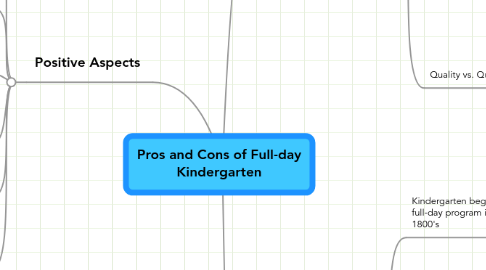
1. Positive Aspects
1.1. Eighty-five percent of kindergartners in the United States attend public school.
1.2. According to the published 2004 National Center for Educational Statistics: As found in other studies, children in a full-day kindergarten program generally make greater gains in both reading and math compared to children in half-day kindergarten
1.3. "What are full-day kindergarten children doing during this 'extra' time?"
1.3.1. Full Day day care curriculum includes: Reading and Language Arts, Mathematics, Social Studies, and Music
1.4. Sixty-four percent of half-day classes spend an hour or less on reading compared to 32 percent of full-day classes.
1.4.1. Thirty-one percent of full-day classes spend more than an hour and a half on reading per day compared to 10 percent of half-day classes
1.5. More full-day classes have mathematics daily compared to half-day classes
1.5.1. Twenty-one percent of full-day classes spend more than an hour doing mathematics activities compared to 9 percent of half-day classes.
1.6. Full-day kindergarten programs take advantage of the longer day by providing child-centered, developmentally appropriate activities and offering a balance of small group, large group, and individual activities
2. Negative Aspects
2.1. Not all States agree to make full-day kindergarten mandatory or even available in all districts
2.2. Implementing full-day programs requires more money from local and federal budgets
2.2.1. Some parents in some districts must pay tuition for full-day programs, this is not always possible
2.2.2. some parents, no matter what their circumstances or the cost, are not willing to pay tuition for public education
2.2.3. with current state and local budget deficits, full-day programs are an irresponsible use of funds until more substantiated research is done to prove the benefits of full-day instruction
2.3. no studies that show an absolute answer that full-day kindergarten achievement out weighs half-day kindergarten achievement
2.3.1. some studies show that over the course of the elementary years, half -day kindergartners are shown at no disadvantage to full-day
2.3.2. While some studies showed raised achievement in literacy skills and mathematics by full-time kindergartners - results are short lived and fall dramatically over the course of first grade.
2.4. Full-day kindergarten - longer days at school may contribute to later "burn-out" and low motivation in school in later years.
2.5. Quality vs. Quantity
2.5.1. full-day focus more academic or getting child ready for first grade rather than the "whole" child
2.5.1.1. kindergarten grassroots - nurturing environment with play and socialization as primary focus
2.5.2. concern for child's overall development is overshadowed by academic achievement
2.5.2.1. children are expected to achieve beyond their developmental capabilities
2.5.2.1.1. children at this age may not be able to cope with long hours of academic instruction
2.5.3. some five year olds are not mature enough to be away from mother all day without napping.
2.5.3.1. children are at risk for more stress and fatigue
2.5.4. Although full-day kindergarten is double the amount of time in school, the amount of extra instruction received is minimal
3. History of Full-day kindergarten
3.1. Kindergarten begins as a full-day program in the late 1800's
3.2. Changes to Half-Day around World War II
3.2.1. need for labor - teachers go to work in the war effort
3.2.2. Baby Boom perpetuates half-day Programs
